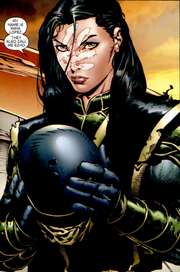 Avatar Book 1: A Look into the Abyss by Script by Juan Miguel Aguilera, art by Rafael Fonteriz SAF Comics, (2003).
Avatar Book 1: A Look into the Abyss by Script by Juan Miguel Aguilera, art by Rafael Fonteriz SAF Comics, (2003).Manuel Gomez is a new breed of detective in the high-tech world of cyber-crime. He is born a "deaf mute" and communicates with special glasses.
Echo, also known as Ronin, is a Marvel Comics superheroine and a
 supporting character of Daredevil. She debuted in Daredevil Vol. 2, #9 (Dec. 1999), and was created by David Mack and Joe Quesada. She is a Hispanic Native American and one of the very few deaf comic characters. Find more information at http://en.wikipedia.org/wiki/Echo_(comics) and http://www.marvel.com/universe/Echo_(Maya_Lopez).
supporting character of Daredevil. She debuted in Daredevil Vol. 2, #9 (Dec. 1999), and was created by David Mack and Joe Quesada. She is a Hispanic Native American and one of the very few deaf comic characters. Find more information at http://en.wikipedia.org/wiki/Echo_(comics) and http://www.marvel.com/universe/Echo_(Maya_Lopez).
 Archie Comics "The Sound of Silence," is about a little deaf girl named Stella. In the story, Archie feels sorry for the the deaf child, and her parents are ignorant of the fact that deaf children can learn. Archie teaches the little girl how to read lips. 1970s
Archie Comics "The Sound of Silence," is about a little deaf girl named Stella. In the story, Archie feels sorry for the the deaf child, and her parents are ignorant of the fact that deaf children can learn. Archie teaches the little girl how to read lips. 1970s
3 comments:
So... which of these would be appropriate for middle school, in your opinion?
I haven't read the entire series so you would want to read through the entire comic/graphic novel before handing it over to a middle school student. That being said, I think that you could use all of them in various ways.
Avatar includes the character Manuel Gomez, a futuristic detective. He communicates with special glasses. Clearly, he isn't a realistic character but I think it would be a good conversation starter for "communication choices". Why do some people decide to use their voice and why do some not.
I think it would be interesting to pair Avatar wih the book Mindfield by John F. Egbert (although it probably isn't appropriate for middle school). It would be interesting to discuss what life would be like in the future if an act of bioterrorism caused deafness to spread throughout the entire country.
Echo or Ronin is a supporting character. I think it would be interesting to discuss deaf characters' roles as "supporting characters". Until recently it was rare for a deaf character to be the main character, unless of course you're reading books like The Heart is a Lonely Hunter.
For the Archie Comics, I would have to take the historical tendency for readers to "feel sorry for" the deaf character. Again, this one brings up the issues of lipreading as an easy choice by Deaf people. I would certainly discuss that. Writing that, it seems like a good time to plug artist Joseph Grigely's work on lipreading that featured at Baltimore's Contemporary Museum. (http://www.contemporary.org/exhibitions.html)
Here's a tidit about a character that was supposed to be written as deaf -- was supposed to be Marvel's first deaf mutant character, apparently -- but had her origins changed. Just look for the last "urban legend" entry.
http://goodcomics.comicbookresources.com/2007/08/16/comic-book-urban-legends-revealed-116/
Post a Comment